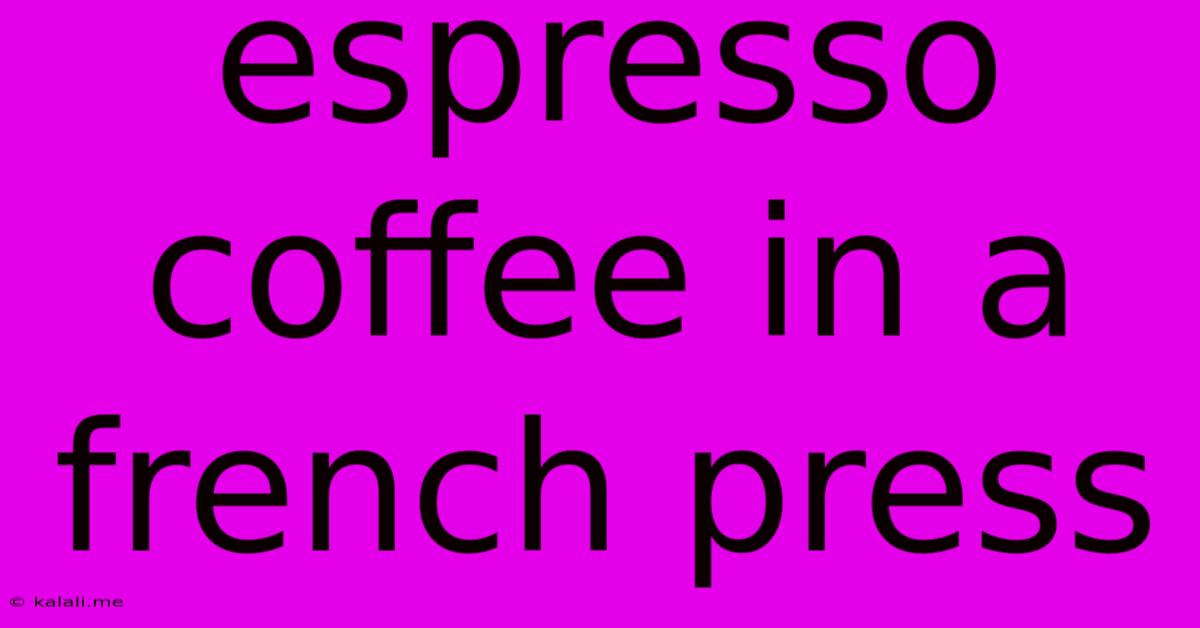Espresso Coffee In A French Press
Kalali
Jun 07, 2025 · 4 min read

Table of Contents
Brewing Espresso in a French Press: A Surprisingly Good Alternative
Meta Description: Discover the unexpected deliciousness of espresso brewed in a French press! Learn the technique, explore the nuances of flavor, and find out why this method is gaining popularity among coffee aficionados.
Forget the fancy espresso machines; brewing espresso in a French press might be the unexpected hack you've been waiting for. While not technically espresso in the truest sense (lacking the high pressure extraction), this method delivers a surprisingly concentrated and flavorful coffee that resembles the rich body and intensity of a proper espresso shot. This article explores this unconventional brewing technique, guiding you through the process and highlighting its advantages and disadvantages.
Why Try French Press Espresso?
The beauty of this method lies in its simplicity and accessibility. If you don't own an espresso machine but crave that intense espresso experience, a French press offers a surprisingly viable solution. It’s a cost-effective alternative that allows you to experiment with different coffee beans and grind sizes, ultimately leading to a more personalized coffee experience. This technique also produces a coffee with less acidity compared to traditional espresso methods, a plus for those sensitive stomachs.
What You'll Need:
- High-Quality Coffee Beans: Freshly roasted, finely ground beans are crucial. A medium-fine grind, similar to what you'd use for Turkish coffee, is ideal. Experiment with different roasts to discover your preference. Arabica beans are generally recommended for their rich flavor profiles.
- French Press: A standard 8-cup French press works well for a few shots of concentrated coffee.
- Gooseneck Kettle: Essential for precise water pouring and achieving even saturation.
- Timer: Accurate timing is key for consistent results.
- Scale: Weighing your coffee and water helps maintain consistency and allows for precise adjustments based on your taste.
Brewing Guide: The French Press Espresso Method
- Grind Size: Grind your beans to a fine consistency, almost like table salt. This fine grind is essential for maximizing extraction.
- Water Temperature: Heat your water to around 200°F (93°C). This temperature is crucial for optimal flavor extraction without burning the coffee grounds. A gooseneck kettle enables better control over the water flow.
- Coffee-to-Water Ratio: A good starting point is a 1:2 ratio (e.g., 30 grams of coffee to 60 grams of water). You can adjust this ratio based on your personal preferences.
- Bloom: Add the ground coffee to the French press and slowly pour just enough hot water to saturate the grounds. Let it "bloom" for about 30 seconds. This allows the coffee to degas and release its aromas.
- Extraction: Gently pour the remaining hot water over the grounds, ensuring all the coffee is saturated. Stir gently once to ensure a consistent extraction.
- Steep: Steep the coffee for 4 minutes. Don't exceed this time, or you'll risk over-extraction and bitterness.
- Press: Slowly and steadily press the plunger down. Avoid pressing too quickly, as this can cause grounds to seep into the brewed coffee.
- Serve: Immediately pour your "espresso" into a pre-warmed cup. Enjoy!
Tips for Success:
- Experiment with Grind Size: Fine-tuning your grind size is key to finding the perfect balance of flavor and body. A slightly coarser grind can reduce bitterness if needed.
- Water Quality: Use filtered water for the best taste and to avoid affecting the final flavor profile.
- Cleanliness: Ensure your French press is thoroughly cleaned after each use to avoid residual grounds affecting future brews.
French Press vs. Traditional Espresso: Key Differences
While this method offers a concentrated coffee similar to espresso, there are key differences. The French press lacks the high pressure extraction of a traditional espresso machine, resulting in a slightly different texture and mouthfeel. The French press method tends to produce a more full-bodied, less acidic coffee. It's about embracing the unique characteristics this method offers rather than trying to perfectly replicate traditional espresso.
Conclusion:
Brewing espresso in a French press is a rewarding adventure for coffee enthusiasts. While it deviates from traditional methods, it offers a simplified, accessible, and surprisingly delicious way to enjoy a concentrated coffee experience at home. Embrace the experimentation, fine-tune your technique, and enjoy the unique flavor profile this method provides!
Latest Posts
Latest Posts
-
Why Is Email In All Mail And Not In Inbox
Jun 07, 2025
-
What Happens If You Dont Move Clara
Jun 07, 2025
-
How Many Missions Are In Mgs5
Jun 07, 2025
-
How To Unclog A Vent Pipe
Jun 07, 2025
-
How To Avoid Duplicate Accounts For An App
Jun 07, 2025
Related Post
Thank you for visiting our website which covers about Espresso Coffee In A French Press . We hope the information provided has been useful to you. Feel free to contact us if you have any questions or need further assistance. See you next time and don't miss to bookmark.